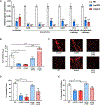Staphylococcus aureus uses the ArlRS and MgrA cascade to regulate immune evasion during skin infection
- PMID: 34320352
- PMCID: PMC8450000
- DOI: 10.1016/j.celrep.2021.109462
Staphylococcus aureus uses the ArlRS and MgrA cascade to regulate immune evasion during skin infection
Abstract
Skin is one of the most common sites of host immune response against Staphylococcus aureus infection. Here, through a combination of in vitro assays, mouse models, and intravital imaging, we find that S. aureus immune evasion in skin is controlled by a cascade composed of the ArlRS two-component regulatory system and its downstream effector, MgrA. S. aureus lacking either ArlRS or MgrA is less virulent and unable to form correct abscess structure due to de-repression of a giant surface protein, Ebh. These S. aureus mutants also have decreased expression of immune evasion factors (leukocidins, chemotaxis-inhibitory protein of S. aureus [CHIPS], staphylococcal complement inhibitor [SCIN], and nuclease) and are unable to kill neutrophils, block their chemotaxis, degrade neutrophil extracellular traps, and survive direct neutrophil attack. The combination of disrupted abscess structure and reduced immune evasion factors makes S. aureus susceptible to host defenses. ArlRS and MgrA are therefore the main regulators of S. aureus immune evasion and promising treatment targets.
Keywords: Staphylococcus aureus; abscess; gene regulation; immune evasion; innate immunity; intravital microscopy; neutrophil; skin infection; surface proteins.
Copyright © 2021 The Authors. Published by Elsevier Inc. All rights reserved.
Conflict of interest statement
Declaration of interests The authors declare no competing interests.
Figures







Similar articles
-
Staphylococcus aureus adhesion in endovascular infections is controlled by the ArlRS-MgrA signaling cascade.PLoS Pathog. 2019 May 22;15(5):e1007800. doi: 10.1371/journal.ppat.1007800. eCollection 2019 May. PLoS Pathog. 2019. PMID: 31116795 Free PMC article.
-
The Staphylococcus aureus Global Regulator MgrA Modulates Clumping and Virulence by Controlling Surface Protein Expression.PLoS Pathog. 2016 May 4;12(5):e1005604. doi: 10.1371/journal.ppat.1005604. eCollection 2016 May. PLoS Pathog. 2016. PMID: 27144398 Free PMC article.
-
Epic Immune Battles of History: Neutrophils vs. Staphylococcus aureus.Front Cell Infect Microbiol. 2017 Jun 30;7:286. doi: 10.3389/fcimb.2017.00286. eCollection 2017. Front Cell Infect Microbiol. 2017. PMID: 28713774 Free PMC article. Review.
-
Disruption of Glycolysis by Nutritional Immunity Activates a Two-Component System That Coordinates a Metabolic and Antihost Response by Staphylococcus aureus.mBio. 2019 Aug 6;10(4):e01321-19. doi: 10.1128/mBio.01321-19. mBio. 2019. PMID: 31387906 Free PMC article.
-
Immune Evasion by Staphylococcus aureus.Microbiol Spectr. 2019 Mar;7(2):10.1128/microbiolspec.gpp3-0061-2019. doi: 10.1128/microbiolspec.GPP3-0061-2019. Microbiol Spectr. 2019. PMID: 30927347 Free PMC article. Review.
Cited by
-
Identification of an antivirulence agent targeting the master regulator of virulence genes in Staphylococcus aureus.Front Cell Infect Microbiol. 2023 Oct 31;13:1268044. doi: 10.3389/fcimb.2023.1268044. eCollection 2023. Front Cell Infect Microbiol. 2023. PMID: 38029271 Free PMC article.
-
The biofilm community resurfaces: new findings and post-pandemic progress.J Bacteriol. 2023 Oct 26;205(10):e0016623. doi: 10.1128/jb.00166-23. Epub 2023 Sep 27. J Bacteriol. 2023. PMID: 37756166 Free PMC article. Review.
-
Octanoic acid promotes clearance of antibiotic-tolerant cells and eradicates biofilms of Staphylococcus aureus isolated from recurrent bovine mastitis.Biofilm. 2023 Aug 12;6:100149. doi: 10.1016/j.bioflm.2023.100149. eCollection 2023 Dec 15. Biofilm. 2023. PMID: 37635811 Free PMC article.
-
The Staphylococcus aureus ArlS Kinase Inhibitor Tilmicosin Has Potent Anti-Biofilm Activity in Both Static and Flow Conditions.Microorganisms. 2024 Jan 25;12(2):256. doi: 10.3390/microorganisms12020256. Microorganisms. 2024. PMID: 38399660 Free PMC article.
-
Staphylococcus aureus and Neutrophil Extracellular Traps: The Master Manipulator Meets Its Match in Immunothrombosis.Arterioscler Thromb Vasc Biol. 2022 Mar;42(3):261-276. doi: 10.1161/ATVBAHA.121.316930. Epub 2022 Feb 3. Arterioscler Thromb Vasc Biol. 2022. PMID: 35109674 Free PMC article. Review.
References
-
- Baba T, Takeuchi F, Kuroda M, Yuzawa H, Aoki K, Oguchi A, Nagai Y, Iwama N, Asano K, Naimi T, et al. (2002). Genome and virulence determinants of high virulence community-acquired MRSA. Lancet 359, 1819–1827. - PubMed
-
- Bai J, Zhu X, Zhao K, Yan Y, Xu T, Wang J, Zheng J, Huang W, Shi L, Shang Y, et al. (2019). The role of ArlRS in regulating oxacillin susceptibility in methicillin-resistant Staphylococcus aureus indicates it is a potential target for antimicrobial resistance breakers. Emerg. Microbes Infect 8, 503–515. - PMC - PubMed
-
- Bassetti M, Carnelutti A, and Righi E (2017). The role of methicillin-resistant Staphylococcus aureus in skin and soft tissue infections. Curr. Opin. Infect. Dis 30, 150–157. - PubMed
Publication types
MeSH terms
Substances
Grants and funding
LinkOut - more resources
Full Text Sources
Medical

